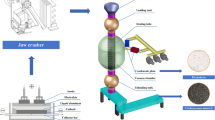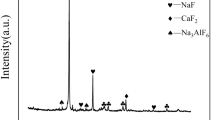Abstract
The spent cathode carbon block (SCCB) produced from the overhaul aluminum reduction cell is regarded as hazardous solid waste because it contains a large amount of soluble fluoride and small amount of cyanide. Coupling vacuum-heating method is considered an effective way to address the issues of such hazardous waste. Herein, SCCB is processed under the conditions of 3000 Pa and 1673–1973 K. The correlation between soluble fluoride content and treatment time was analyzed. The apparent activation energy of the detoxification reaction was calculated based on the Arrhenius equation. The rate-determining step of the detoxification process has also been analyzed in detail. The results show that the detoxification process is a first-order reaction. The apparent activation energy was k = 15.08 kJ mol−1, and gas diffusion was the rate-determining step of the detoxification reaction.
Graphical Abstract








Similar content being viewed by others
References
Breault R, Poirier S, Hamel G, Pucci A (2011) A green way to deal with spent pot lining. Al Int Today 23:22–24
Sleap SB, Turner BD, Sloan SW (2015) Kinetics of fluoride removal from spent pot liner leachate (SPLL) contaminated groundwater. J Environ Chem Eng 3:2580–2587. https://doi.org/10.1016/j.jece.2015.09.004
Tschöpe K, Schøning C, Rutlin J, Grande T (2012) Chemical degradation of cathode linings in hall-héroult cells—an autopsy study of three spent pot linings. Metall Mater Trans B 43:290–301. https://doi.org/10.1007/s11663-011-9604-4
Hollywell G, Breault R (2013) An overview of useful methods to treat, recover, or recycle spent potlining. JOM 65:1441–1451. https://doi.org/10.1007/s11837-013-0769-y
Palmieri MJ, Andrade LF, Trento MVC, Eleutério MW, Luber J, Davide LC, Marcussi S (2016) Cytogenotoxic effects of spent pot liner (SPL) and its main components on human leukocytes and meristematic cells of Allium cepa. Water Air Soil Pollut 227:1–10. https://doi.org/10.1007/s11270-016-2809-z
Andrade LF, Davide LC, Gedraite LS, Campos JMS, Azevedo H (2011) Genotoxicity of SPL (spent pot lining) as measured by tradescantia bioassays. Ecotoxicol Environ Saf 74:2065–2069. https://doi.org/10.1016/j.ecoenv.2011.07.008
Andrade LF, Davide LC, Gedraite LS (2010) The effect of cyanide compounds, fluorides, aluminum, and inorganic oxides present in spent pot liner on germination and root tip cells of Lactuca sativa. Ecotoxicol Environ Saf 73:626–631. https://doi.org/10.1016/j.ecoenv.2009.12.012
Turner BD, Binning PJ, Sloan SW (2008) A calcite permeable reactive barrier for the remediation of fluoride from spent potliner (SPL) contaminated groundwater. J Contam Hydrol 95:110–120. https://doi.org/10.1016/j.jconhyd.2007.08.002
Flores IV, Fraiz F, Lopes Junior RA, Bagatini MC (2019) Evaluation of spent pot lining (SPL) as an alternative carbonaceous material in ironmaking processes. J Mater Res Technol 8:33–40. https://doi.org/10.1016/j.jmrt.2017.11.004
Mazumder B, Devi SR (2013) Conversion of byproduct carbon obtained from spent pot liner. J Appl Chem 3:24–30. https://doi.org/10.9790/5736-0352430
Yu DW, Chattopadhyay K (2018) Enhancement of the nickel converter slag-cleaning operation with the addition of spent potlining. Int J Min Met Mater 25:881–891. https://doi.org/10.1007/s12613-018-1637-0
Xu YT, Yang B, Liu XM, Gao S, Li DS, Mukiza E, Li HJ (2018) Investigation of the medium calcium based non-burnt brick made by red mud and fly ash: durability and hydration characteristics. Int J Min Met Mater 26:983–991. https://doi.org/10.1007/s12613-019-1814-9
Lisbona DF, Somerfield C, Steel KM (2013) Leaching of spent pot-lining with aluminium nitrate and nitric acid: effect of reaction conditions and thermodynamic modelling of solution speciation. Hydrometallurgy 134–135:132–143. https://doi.org/10.1016/j.hydromet.2013.02.011
Gomes V, Drumond PZ, Neto JOP, Lira AR (2005) Co-processing at cement plant of spent potlining from the aluminum industry. In: Essential readings in light metals, volume 4: Electrode technology for aluminum production. https://doi.org/10.1007/978-3-319-48200-2_142
Wang XP, Sun TC, Kou J, Li ZC, Tian Y (2018) Feasibility of co-reduction roasting of a saprolitic laterite ore and waste red mud. Int J Min Met Mater 25:591–597. https://doi.org/10.1007/s12613-018-1606-7
Hu CY, Lo SL, Kuan WH, Lee YD (2005) Removal of fluoride from semiconductor wastewater by electrocoagulation-flotation. Water Res 39:895–901. https://doi.org/10.1016/j.watres.2004.11.034
Reardon EJ, Wang Y (2000) A limestone reactor for fluoride removal from wastewaters. Environ Sci Technol 34:3247–3253. https://doi.org/10.1021/es990542k
Birry L, Leclerc S, Poirier S (2016) The LCL & L process: a sustainable solution for the treatment and recycling of spent potlining. In: Light metals 2016. https://doi.org/10.1002/9781119274780.ch77
Brooks DG, Cutshall ER, Banker DB (1992) Thermal treatment of spent potliner in a rotary kiln. In: Essential readings in light metals, volume 4: Electrode technology for aluminum production. https://doi.org/10.1002/9781118647745.ch140
Xie MZ, Li RB, Zhao HL, Liu W, Lu TT, Liu FQ (2020) Detoxification of spent cathode carbon blocks from aluminum smelters by joint controlling temperature-vacuum process. J Clean Prod 249:1–10. https://doi.org/10.1016/j.jclepro.2019.119370
Li N, Gao L, Chattopadhyay K (2019) Migration behavior of fluorides in spent potlining during vacuum distillation method. Light Met. https://doi.org/10.1007/978-3-030-05864-7_105
Savov L, Janke D (2000) Evaporation of Cu and Sn from induction stirred iron-based melts treated at reduced pressure. ISIJ Int 40:95–104. https://doi.org/10.2355/isijinternational.40.95
Nasr MI, Omar AA, Khedr MH, Elgeassy AA (1995) Effect of nickel oxide doping on the kinetics and mechanism of iron oxide reduction. ISIJ Int 35:1043–1049
Acknowledgements
This study was supported by the National Key Research and Development Program of China (2019YFC1908403) and Key R&D Program of Ningxia Hui Autonomous Region (2018BDE02050).
Author information
Authors and Affiliations
Corresponding author
Ethics declarations
Conflict of interest
On behalf of all authors, the corresponding author states that there is no conflict of interest.
Additional information
The contributing editor for this article was U. Pal.
Publisher's Note
Springer Nature remains neutral with regard to jurisdictional claims in published maps and institutional affiliations.
Rights and permissions
About this article
Cite this article
Xie, Mz., Zhao, Hl., Wu, Zg. et al. Study on Kinetics of Vacuum Heat Treatment Process of the Spent Cathode Carbon Blocks from Aluminum Smelters. J. Sustain. Metall. 6, 715–723 (2020). https://doi.org/10.1007/s40831-020-00311-5
Received:
Accepted:
Published:
Issue Date:
DOI: https://doi.org/10.1007/s40831-020-00311-5




